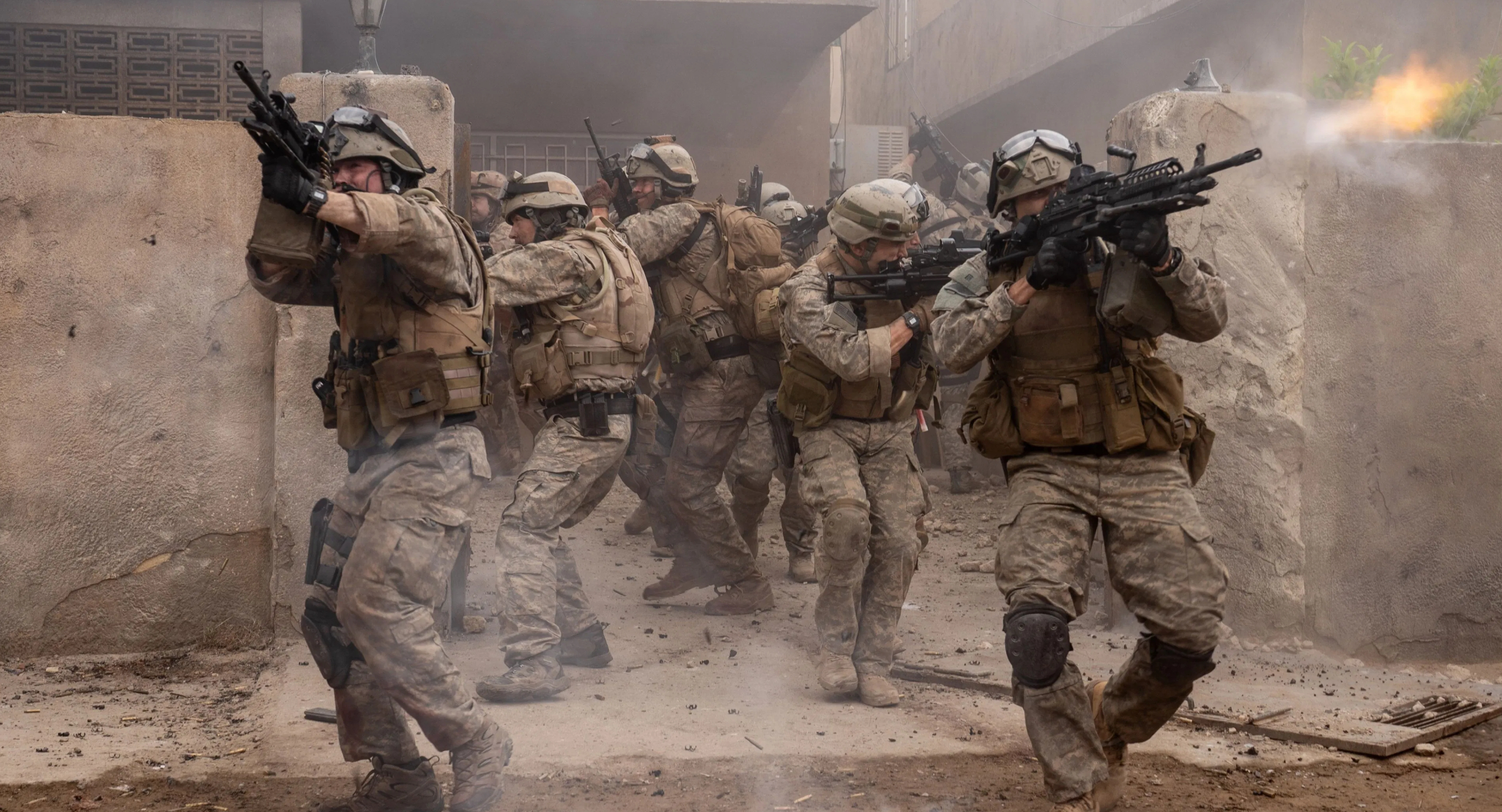Warfare – Film Review
Published April 9, 2025

Not even a full year after the release of Civil War, acclaimed filmmaker Alex Garland is behind the camera once more to direct another film in the same realm, this time in the form of Warfare, alongside Ray Mendoza. This is not merely another addition to the war film genre—it is a raw, immersive plunge into one of the most violent chapters of the Iraq War. Based on Mendoza’s own combat experiences as a U.S. Navy SEAL during the 2006 Battle of Ramadi, the film strips away the genre’s usual gloss and romanticism. What’s left is a nerve-shredding depiction of camaraderie, survival, and trauma—unflinchingly honest and viscerally real.
Told entirely in real time over the course of a two-hour mission gone wrong, Warfare thrusts the viewer into insurgent-held territory with a platoon of SEALs who are quickly pulled from a reconnaissance assignment into a firefight of nightmarish proportions. The sense of immediacy is palpable from the first frame, and Garland’s cinematic expertise—paired with Mendoza’s unfiltered authenticity—yields one of the most intense and grounded portrayals of modern warfare in years.
Their lead SEAL team’s objective is to gather intelligence on a suspected insurgent network operating in a devastated sector of Ramadi. It’s November 2006, and the city is still one of the most lethal battlegrounds in Iraq. But what begins as a surveillance op quickly derails when unexpected movement triggers a premature firefight, forcing the men to adapt, retreat, and re-engage—all while attempting to stay alive behind enemy lines.
Unlike conventional war films, Warfare abandons structured arcs or tidy resolutions. There are no patriotic speeches or soaring orchestral scores—just the constant hum of tension, punctuated by sharp bursts of violence. Mendoza and Garland craft the film with an almost documentary-like intensity, layering handheld camerawork, minimalistic dialogue, and real-time pacing that rarely allows the audience to breathe. At times, it feels closer to United 93 or Son of Saul than Black Hawk Down—claustrophobic, kinetic, and grounded in the minutiae of soldiering.
At the emotional core is D’Pharaoh Woon-A-Tai, who portrays Mendoza himself. As a communicator and Joint Terminal Attack Controller (JTAC), Mendoza’s role is to coordinate air support in the heat of battle, and Woon-A-Tai nails the combination of pressure, composure, and desperation. He delivers a performance that is largely internal—quiet but weighted, bearing the scars of past missions even as the current one spirals out of control.
Will Poulter, as Erik, the Officer in Charge, brings gravitas and brittle restraint to the screen. His calm, decisive demeanor starts to fracture as the situation deteriorates, giving Poulter room to explore moral complexity and leadership under impossible circumstances. Cosmo Jarvis, playing Corpsman/sniper Elliot Miller, injects grit and dark humor into the proceedings—his performance is a study in sustained tension and emotional fatigue. Jarvis delivers a standout moment late in the film during a makeshift medical intervention, blending panic and focus with chilling precision.
Joseph Quinn (Sam), Kit Connor (Tommy), and the rest of the ensemble—including Michael Gandolfini, Taylor John Smith, Henry Zaga, and Charles Melton—form a tightly woven tapestry of personalities. No one feels like filler. Each character, though often introduced with little exposition, is defined by action, tone, and how they respond under fire. Even without knowing all their names, you feel the loss when one falls, the relief when one survives, and the weariness when they all stop to breathe—if only for a second.
The real-time gimmick isn’t just a stylistic flourish—it’s an emotional anchor. Every second that ticks by without extraction ramps up the anxiety. Cinematographer David J. Thompson uses dim natural lighting and a nearly colorless palette to reflect the dust-choked bleakness of Ramadi. His camera often lingers on the faces of soldiers too afraid to blink, too wired to collapse.
Sound design is crucial here. The staccato bursts of gunfire are deafening, concussive. There’s no Hollywood soundscape—just harsh cracks, ragged breathing, and the distant thrum of approaching helicopters or radio static.
Combat sequences are choreographed with brutal precision. Rather than sensationalizing action, the directors choose confusion and exhaustion. You feel the pressure behind every bullet and every command shouted into a malfunctioning comms unit.
If Warfare has a thematic through-line beyond sheer survival, it’s the bond between soldiers. Mendoza and Garland resist sentimentalism but do not ignore the emotional core. The brotherhood isn’t spoken about—it’s observed in small glances, gestures, the way men cover each other without a second thought.
There are moments when Warfare’s commitment to real-time tension can feel like a double-edged sword. A few sequences lose momentum, particularly during prolonged stealth transitions or regrouping pauses that, while realistic, test audience patience. Additionally, viewers hoping for broader commentary on the Iraq War—on policy, strategy, or ethics—may find the film too narrowly focused on the micro. Warfare is not The Hurt Locker or Restrepo in that sense—it doesn’t invite political discourse so much as it insists you survive the mission alongside these men.
But that’s by design. Mendoza and Garland are more interested in capturing what war feels like minute to minute than in interrogating why it happens. The result is a relentlessly visceral, emotionally resonant portrait of modern combat—and a deeply personal testament to those who endured it.
Warfare stands apart as a war film not interested in mythology but in memory. By choosing to frame the story through real-time immediacy, grounded performances, and meticulous attention to combat realism, Ray Mendoza and Alex Garland offer something rare: a war film without hero worship, without easy answers—just the brutal truth of being there. It’s a sensory gauntlet, a tribute, and a reckoning all at once.
